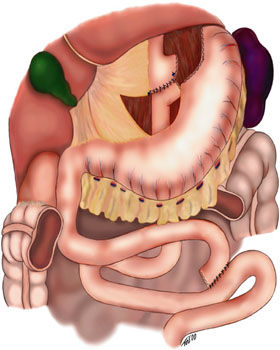- Written by Site Staff
- On Aug 06 2013,
- In Gastric Sleeve Surgery
Diagnostic Laparoscopy
Any injury, such as a surgical operation, causes the body to increase the coagulation of the blood. Simultaneously, activity may be reduced. There is an increased probability of formation of clots in the veins of the legs, or sometimes the pelvis, particularly in the morbidly obese patient. A clot which breaks free and floats to the lungs is called a pulmonary embolus, a very dangerous occurrence. Blood thinners are commonly administered before surgery to reduce the probability of this type of complication.
Prior to 1990, the only specialty performing laparoscopy on a widespread basis was gynecology, mostly for relatively short, simple procedures such as a diagnostic laparoscopy or tubal ligation. The introduction in 1990 of a laparoscopic clip applier with twenty automatically advancing clips (rather than a single load clip applier that would have to be taken out, reloaded and reintroduced for each clip application) made general surgeons more comfortable with making the leap to laparoscopic cholecystectomies (gall bladder removal). On the other hand, some surgeons continue to use the single clip appliers as they save as much as $200 per case for the patient, detract nothing from the quality of the clip ligation, and add only seconds to case lengths.
After the operation has been made, a special gastric sleeve post op diet should be followed. It consists of four stages, with each one having a specific purpose, but all of them being important for your health and well-being. Following a special diet after gastric sleeve will help minimize complications and negative side effects, as well as assist in the weight loss process.
Any major surgery involves the potential for complications—adverse events which increase risk, hospital stay, and mortality. Some complications are common to all abdominal operations, while some are specific to bariatric surgery.
In the past, serious obesity was interpreted to mean weighing at least 100 pounds (45 kg) more than the “ideal body weight”, an actuarially determined body weight at which one was estimated to be likely to live the longest, as determined by the life insurance industry. This criterion failed for persons of short stature.
Deciding on the perfect bariatric surgery for your condition is of the utmost importance. So is finding the correctly location. Regardless if you undertake the lap band, gastric sleeve or gesture bypass, explore the hospitals, medical groups and surgeons to make your fat and health targets an actuality.
After the surgery, the patients may have to stay in the hospital for a few days. The patient has to stay on a liquid diet for about two weeks after the surgery, which is then replaced by semi-solid foods for another two weeks. After this period, the patient is allowed to eat solid food. The complications that may occur due to the gastric sleeve surgery include blood clots, leaks in the sleeve and infections. In certain cases, the patients may regain the weight lost after the surgery.
No accurate number of adjustments required can be given. The amount of saline/isotonic solution needed in the band varies from patient to patient. There are a small number of people who find they do not need a fill at all and have sufficient restriction immediately following surgery. Others may need significant adjustments to the maximum the band is able to hold.
Laparoscopic surgery is performed using several small incisions, or ports: one to insert a surgical telescope connected to a video camera, and others to permit access of specialized operating instruments. The surgeon views his operation on a video screen. Laparoscopy is also called limited access surgery, reflecting the limitation on handling and feeling tissues and also the limited resolution and two-dimensionality of the video image. With experience, a skilled laparoscopic surgeon can perform most procedures as expeditiously as with an open incision—with the option of using an incision should the need arise.
There are also user-friendly non robotic assistance systems that are single hand guided devices with a high potential to save time and money. These assistance devices are not bound by the restrictions of common medical robotic systems. The systems enhance the manual possibilities of the surgeon and his/her team, regarding the need of replacing static holding force during the intervention.
Posts related to Diagnostic Laparoscopy
by Site Staff
Categories
Recent Posts
-
Gastric Sleeve Post Op Diet
Aug, 13, 2013
-
Gastric Sleeve Surgery – Benefits and ...
Aug, 12, 2013
-
The Gastric Sleeve Diet
Aug, 09, 2013
-
Considering Gastric Sleeve Surgery?
Aug, 08, 2013
-
Gastric Sleeve For Weight Loss – The F...
Aug, 07, 2013
-
Diagnostic Laparoscopy
Aug, 06, 2013
-
Gastric Band Surgery
Aug, 06, 2013














